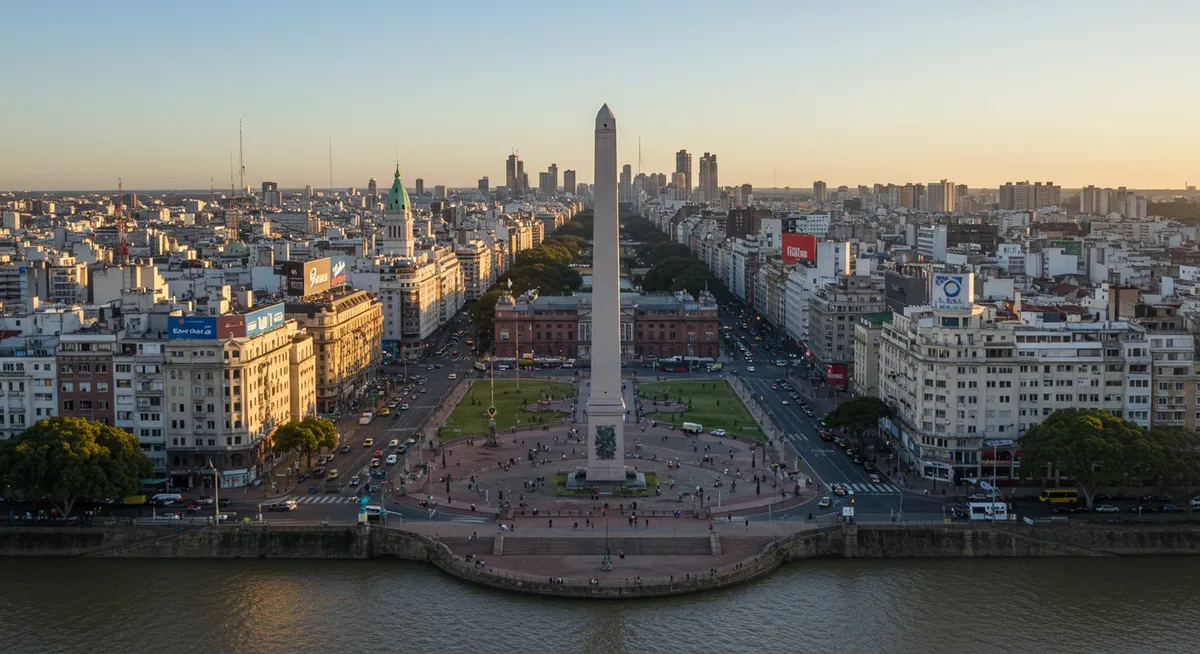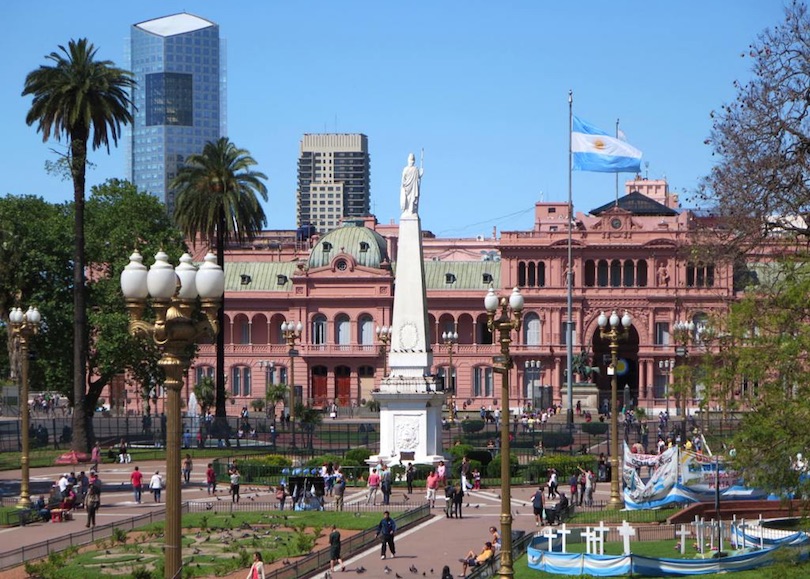
Buenos Aires, the vibrant capital of Argentina, pulsates with an irresistible energy, a captivating blend of European elegance and Latin American passion. From its storied past, echoing with tango rhythms and revolutionary fervor, to its present-day dynamism, this sprawling metropolis offers a kaleidoscope of experiences for every traveler. Whether you’re drawn to its grand architecture, its passionate culture, its culinary delights, or its captivating history, Buenos Aires promises an unforgettable journey.
A Tapestry Woven Through Time: A Glimpse into Buenos Aires’ History
The story of Buenos Aires is one of ambition, resilience, and cultural fusion. Founded in 1536 by Pedro de Mendoza, the city struggled through early attempts at settlement, eventually being re-established in 1580. Its strategic location on the Río de la Plata made it a vital port for the Spanish Empire, leading to significant growth and wealth, particularly through cattle ranching and the export of hides.

Related Articles about Buenos Aires: A Symphony of Passion, History, and Unforgettable Attractions:
- Iceland: A Land of Fire and Ice, and Unforgettable Adventures
- Bulgaria’s Crown Jewels: Unveiling the Best Hotels Amidst Ancient Wonders and Modern Comforts
- Slovenia’s Crown Jewels: Unveiling the Best Hotels Amidst Alpine Majesty and Adriatic Charm
- Switzerland: A Land of Enchantment – Exploring the Top Attractions and Planning Your Perfect Trip
- Mexico: A Kaleidoscope of Culture, History, and Natural Wonders
The 19th century marked a pivotal era. Buenos Aires declared independence from Spain in 1816, and the subsequent decades saw the city transform into a major economic and cultural hub. Waves of European immigration, primarily from Italy and Spain, profoundly shaped its architecture, language, cuisine, and societal fabric, creating the distinct "Porteño" identity. The early 20th century witnessed a golden age, characterized by opulent architecture and a thriving arts scene. However, the latter half of the century was marked by political instability, economic fluctuations, and periods of military rule, all of which have left their indelible mark on the city’s character and its people’s spirit. Today, Buenos Aires stands as a testament to its enduring strength and its capacity to reinvent itself while cherishing its rich heritage.
The Heartbeat of the City: Top Attractions in Buenos Aires
Buenos Aires is a city that rewards exploration, with each neighborhood offering its unique charm and a wealth of attractions. Here are some of the must-see sights:
-
Plaza de Mayo: The historical and political heart of Buenos Aires, this iconic square has witnessed centuries of pivotal events, from independence declarations to mass protests. Dominating the plaza is the Casa Rosada (Pink House), the presidential palace, famous for its balconies where leaders address the nation. Also on the plaza are the Metropolitan Cathedral, where Pope Francis once served as Archbishop, and the Cabildo, the former town hall, now a museum preserving colonial history. The Mothers of the Plaza de Mayo, a courageous group who have fought for human rights since the military dictatorship, continue to gather here, a poignant reminder of the city’s past struggles.
-
La Boca & Caminito: Prepare for a sensory explosion in La Boca, especially along the vibrant pedestrian street of Caminito. This charming area, characterized by its brightly painted corrugated iron houses, evokes the spirit of tango and the early immigrant communities. Street artists, musicians, and dancers fill the air with energy. While undeniably picturesque, it’s advisable to stay within the main tourist areas of Caminito due to safety concerns in other parts of La Boca. The nearby La Bombonera stadium, home to the legendary Boca Juniors football club, is a pilgrimage site for football enthusiasts.

-
Recoleta Cemetery: Far from being morbid, Recoleta Cemetery is an extraordinary open-air museum of funerary art and architecture. This elegant necropolis is a labyrinth of ornate mausoleums, many resembling miniature palaces, housing the remains of Argentina’s most prominent figures, including Eva Perón (Evita). Wandering through its marble avenues is a fascinating and surprisingly peaceful experience, offering a glimpse into the city’s past elite.
-
Palermo: Buenos Aires’ largest neighborhood is a sprawling green oasis and a hub of trendy boutiques, chic cafes, and vibrant nightlife. Within Palermo, you’ll find several distinct areas:
- Palermo Soho: Known for its bohemian vibe, independent designer shops, and lively bars.
- Palermo Hollywood: A more sophisticated area with upscale restaurants and production studios.
- Bosques de Palermo (Palermo Woods): A vast parkland perfect for leisurely strolls, picnics, and boating. Highlights include the Rosedal (Rose Garden), a stunning collection of roses, and the Planetarium Galileo Galilei.
-
San Telmo: This historic neighborhood is the soul of tango and a treasure trove for antique lovers. On Sundays, the San Telmo Market transforms Defensa Street into a bustling pedestrian promenade filled with antique stalls, artisan crafts, street performers, and tango dancers. Even on other days, the cobblestone streets, colonial architecture, and charming plazas make San Telmo a delight to explore. Don’t miss the Mercado de San Telmo, a historic market hall offering a variety of food stalls and local produce.
-
Teatro Colón: Widely considered one of the world’s finest opera houses, the Teatro Colón is an architectural masterpiece and a cultural icon. Its opulent interiors, exquisite acoustics, and rich history make it a must-visit, even if you don’t attend a performance. Guided tours are available and highly recommended to appreciate its grandeur.
-
El Ateneo Grand Splendid: This former theater, breathtakingly converted into a bookstore, is a truly unique and magical experience. With its gilded balconies, frescoed ceiling, and plush seating areas, it’s a place where you can browse books amidst the grandeur of a bygone era. It’s often cited as one of the most beautiful bookstores in the world.
-
Puerto Madero: Buenos Aires’ modern waterfront district, Puerto Madero, is a testament to urban regeneration. Once a bustling port, it has been transformed into a sophisticated area of upscale restaurants, trendy bars, luxury apartments, and manicured parks. The Puente de la Mujer (Woman’s Bridge), a striking modern pedestrian bridge designed by Santiago Calatrava, is a notable landmark.
Navigating the Porteño Metropolis: Transportation in Buenos Aires
Buenos Aires boasts a well-developed public transportation system, making it relatively easy to get around:
- Subte (Metro): The Subte is the most efficient way to traverse the city, connecting most major attractions and neighborhoods. It’s clean, affordable, and runs frequently. You’ll need a SUBE card to pay for fares, which can be purchased and topped up at Subte stations and various kiosks.
- Buses (Colectivos): An extensive network of buses covers almost every corner of the city. While they can be slower than the Subte due to traffic, they offer a more comprehensive reach and a chance to observe local life. The SUBE card is also used for bus fares.
- Taxis and Ride-Sharing: Taxis are readily available and generally safe. Ensure the meter is used. Ride-sharing apps like Uber and Cabify also operate in Buenos Aires and can be a convenient option.
- Walking: Many of Buenos Aires’ most charming neighborhoods are best explored on foot. Wear comfortable shoes and be prepared for extensive walking.
- Biking: Buenos Aires has been investing in its cycling infrastructure, with dedicated bike lanes in many areas. Bike rental services are available, offering a pleasant way to explore certain neighborhoods.
A Haven for Every Traveler: Accommodation Options
Buenos Aires offers a diverse range of accommodation to suit every budget and travel style:
- Luxury Hotels: For those seeking opulence and impeccable service, areas like Recoleta and Puerto Madero offer world-class hotels with stunning views and top-notch amenities.
- Boutique Hotels: These charming and often stylish hotels are scattered throughout neighborhoods like Palermo Soho, San Telmo, and Recoleta, providing a more intimate and personalized experience.
- Mid-Range Hotels: Buenos Aires has a plethora of comfortable and well-located mid-range hotels that offer good value for money. You’ll find many options in areas like Palermo, Recoleta, and Microcentro.
- Hostels: For budget-conscious travelers and those looking to socialize, Buenos Aires has a thriving hostel scene, particularly in San Telmo and Palermo. They offer dormitory-style rooms and private options, along with communal spaces.
- Apartments and Airbnb: Renting an apartment or an Airbnb is an excellent option for longer stays or for families and groups, offering more space and the opportunity to live like a local.
When to Unveil the Magic: Best Time to Visit Buenos Aires
Buenos Aires enjoys a temperate climate, with distinct seasons that offer different experiences:
- Spring (September to November): This is widely considered the best time to visit. The weather is pleasantly mild, with blooming flowers and comfortable temperatures perfect for exploring the city on foot. The city comes alive with outdoor activities and festivals.
- Autumn (March to May): Another excellent season, with crisp air, beautiful fall foliage, and fewer crowds than in spring. Temperatures are still comfortable for sightseeing.
- Summer (December to February): Summers are hot and humid, with occasional thunderstorms. While lively and vibrant, it can be quite warm for extensive outdoor exploration. Many Porteños also go on vacation during this period.
- Winter (June to August): Winters are cool and dry, with average temperatures ranging from 8-15°C (46-59°F). While not freezing, it can be chilly, especially in the evenings. It’s a good time to visit for those seeking fewer crowds and lower prices, and to enjoy cozy cafes and indoor attractions.
Essential Travel Tips for a Seamless Buenos Aires Adventure:
- Currency: The currency is the Argentine Peso (ARS). Exchange rates can fluctuate, so it’s advisable to check current rates. Credit cards are widely accepted in most establishments, but it’s good to have some cash for smaller purchases and markets.
- Language: Spanish is the official language. While many people in tourist areas speak some English, learning a few basic Spanish phrases will greatly enhance your experience.
- Safety: Buenos Aires is generally safe, but like any large city, it’s important to be aware of your surroundings, especially in crowded areas. Pickpocketing can occur, so keep your valuables secure. Avoid walking alone in dimly lit areas late at night.
- Tipping: Tipping is customary in restaurants, typically around 10% of the bill.
- Electricity: The voltage is 220V, and the plug type is Type I (three flat pins, two angled).
- Water: It’s generally recommended to drink bottled water.
- Bookings: For popular attractions like the Teatro Colón or certain tango shows, it’s advisable to book tickets in advance, especially during peak season.
- Siesta: While less prevalent in the bustling city center, some smaller shops and businesses might close for a few hours in the afternoon.
Beyond the Checklist: Embracing the Porteño Spirit
Buenos Aires is more than just its list of attractions; it’s an experience that unfolds with every step. It’s the passion of a tango performance, the warmth of a shared mate, the aroma of grilled steak wafting from a parilla, and the vibrant conversations spilling out of cafes. It’s a city that invites you to slow down, savor the moment, and immerse yourself in its captivating rhythm. So, pack your bags, open your heart, and let Buenos Aires weave its magic upon you. You won’t be disappointed.





